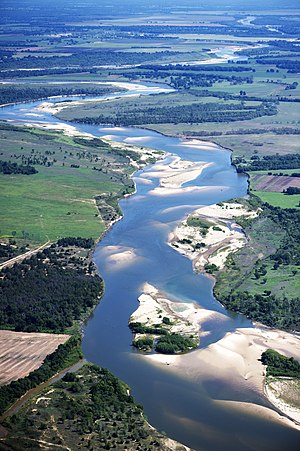| Red River Rivière Rouge (former French name), Río Colorado (former Spanish name) | |
|---|---|
 Red River looking east, north of Bonham, Texas:
Texas is to the right, Oklahoma is on the left, and the border between the two states runs along the south (right) bank of the river. | |
 Map of the Red River watershed | |
| Native name | Bah'hatteno (Caddo)[1] |
| Location | |
| Country | United States |
| States | Texas, Oklahoma, Arkansas and Louisiana |
| Physical characteristics | |
| Source | |
| • location | Confluence of the Prairie Dog Town Fork and Buck Creek, Harmon County, Oklahoma[2] |
| • coordinates | 34°34′35″N 99°57′54″W / 34.57639°N 99.96500°W |
| • elevation | 1,535 ft (468 m)[citation needed] |
| Mouth | |
• location | Atchafalaya River |
• coordinates | 31°01′10″N 91°44′52″W / 31.01944°N 91.74778°W |
• elevation | 30 ft (9.1 m) |
| Length | 1,360 mi (2,190 km) |
| Basin size | 65,595 sq mi (169,890 km2) |
| Discharge | |
| • location | mouth; max and min at Alexandria, LA |
| • average | 57,000 cu ft/s (1,600 m3/s) |
| • minimum | 1,472 cu ft/s (41.7 m3/s) |
| • maximum | 233,000 cu ft/s (6,600 m3/s) |
 | |
The Red River, or sometimes the Red River of the South to differentiate it from the Red River in the north of the continent, is a major river in the Southern United States.[3] It was named for its reddish water color from passing through red-bed country in its watershed.[4] It is known as the Red River of the South to distinguish it from the Red River of the North, which flows between Minnesota and North Dakota into the Canadian province of Manitoba. Although once a tributary of the Mississippi River, the Red River is now a tributary of the Atchafalaya River, a distributary of the Mississippi that flows separately into the Gulf of Mexico. This confluence is connected to the Mississippi River by the Old River Control Structure.
The south bank of the Red River formed part of the US–Mexico border from the Adams–Onís Treaty (in force 1821) until the Texas Annexation and the Treaty of Guadalupe Hidalgo.
The Red River is the second-largest river basin in the southern Great Plains.[5] It rises in two branches in the Texas Panhandle and flows east, where it serves as the border between the states of Texas and Oklahoma. It forms a short border between Texas and Arkansas before entering Arkansas. It forms much of the eastern border of Miller County, Arkansas, turning south near Fulton and flowing into Louisiana, where it feeds the Atchafalaya River. The total length of the river is 1,360 miles (2,190 km), with a mean flow of over 57,000 cubic feet per second (1,600 m3/s) at the mouth.[citation needed]
- ^ Caddo name. Meredith, Howard. "Caddo (Kadohadacho)." Archived 2010-07-19 at the Wayback Machine Oklahoma Historical Society's Encyclopedia of Oklahoma History and Culture. Retrieved 9 Sept 2012)
- ^ Cite error: The named reference
USGSwas invoked but never defined (see the help page). - ^ Tyson, Carl N. The Red River in Southwestern History. Norman: University of Oklahoma Press, 1981. ISBN 0-8061-1659-5
- ^ "Red River Basin". Texas Water Development Board. Retrieved 5 Dec 2020.
- ^ Benke, Arthur; Colbert Cushing (2005). River of North America. Academic Press. p. 1144. ISBN 9780120882533.